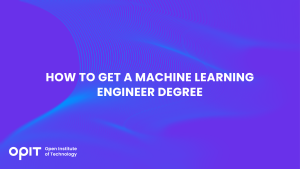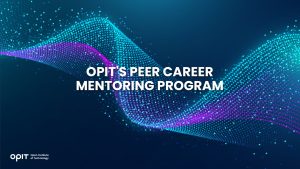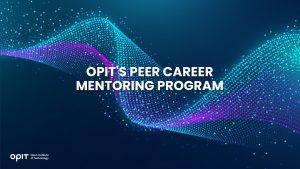

Why study for a machine learning engineer degree?
The simple answer is that the industry is growing explosively. Precedence Research points out that the machine learning market was worth $38.11 billion (approx. €35 billion) in 2022. By 2032, it’ll be worth $771.8 billion (approx. €712 billion). That means the machine learning industry will grow by an average of 35.09% per year between now and 2032.
That growth means one thing:
The industry is going to be looking for people with a machine learning engineer education.
If you pursue a machine learning engineer degree with an accredited institution – such as OPIT – you stand to be at the forefront of one of the fastest-growing industries in the world.
Machine Learning Engineer Education: The Foundation of Your Career
You’ll require a bachelor’s degree in a relevant field – such as computer science, at the very minimum, to start a career in machine learning. However, most roles ask for more. A master’s degree in a field like data science or software engineering will make you a more attractive candidate.
Those requirements also indicate the core subjects you’ll study when working toward a degree for machine learning engineer roles. Math, computer science, statistics, and computer science are all fundamentals that are vital to the industry.
As you move onto the master’s track, you’ll start learning more advanced machine-learning concepts, such as algorithms and data analysis.
Degree for Machine Learning Engineer: Choosing the Right Program
Signing up for the first machine learning engineer bachelor’s degree you find is rarely a wise course of action. You need to weigh your options carefully before choosing a course, with the following factors coming into play:
- Course Content and Curriculum – Look for degrees that include machine learning-specific components – such as feature engineering and model evaluation – ideally with a practical aspect that gives you real-world experience.
- Course Faculty – The “real-world experience” point also applies to your course’s faculty. The best programs are created by those who have experience in the machine learning industry. They understand what employers want to see, as well as the likely applications for the technical knowledge you’ll develop.
- Institution Accreditation – A lack of accreditation hurts the credibility of your machine learning engineer degree. Look for a program that’s accredited by a relevant authority, such as the European Qualifications Framework (EQF).
- The Cost – Master’s degrees in Europe can cost anywhere between €8,000 and €45,000, with the total you’ll pay being a determining factor for which degree you choose. Try to find a balance between the cost and the credibility of the organization offering the degree.
OPIT’s degree programs offer the ideal blend of these factors. They’re affordable – with tuition costing as little as €2,250 per term – and designed by faculty with real-world experience in the machine learning and computer science sector. They’re also accredited by the previously mentioned EQF.
Best Online and Offline Master Programs for Machine Learning Engineering
With the above factors considered, your next choice comes down to location:
Do you study offline or on?
The online course format delivers flexibility, though it means you don’t get to enjoy the on-campus lifestyle. Regardless of which you prefer, the following are the five top machine learning engineer degree courses available in Europe:
OPIT – MSc in Applied Data Science & AI
Beyond excelling in all of the above factors, OPIT’s MSc course offers a mix of live and pre-recorded content to make the online learning experience more interactive. There are no final exams – a relief for students who hate pressure-filled situations – with the course instead focusing on practical assignments with real-world applications.
University of Oxford – MSc in Advanced Computer Science
Offered by one of the U.K.’s leading universities, this MSc takes a broad approach to the AI sector, with machine learning as one of several components. It also covers cybersecurity and the emergence of AI in the medical field. A typical week involves 35 hours of study, eight of which are lectures, with another four covering practical sessions.
University of Cambridge – MPhil in Machine Learning and Machine Intelligence
An 11-month program, this master’s degree covers machine learning, as well as computer vision and robotics, speech and language processing, and how humans interact with computers. Practical exercises also give you a chance to work with Ph.D. students in the machine learning field.
KU Leuven – MSc of Artificial Intelligence
A multidisciplinary program, this master’s degree accepts students with backgrounds in subjects like psychology and economics. As such, it’s a good choice for those who have completed a bachelor’s degree in a non-tech subject and don’t want to restart their education careers. It covers the fundamentals but practically-minded students should beware – the course emphasizes technical knowledge.
Technical University of Munich – Data Engineering and Analytics MSc
Another on-campus degree, TUM’s course covers machine learning, along with key data science techniques such as computer vision and scientific visualization. But the focus is on Big Data – the driving force in everything from machine learning to self-driving vehicles.
The Future of Technology: Machine Learning Applications
You’ve seen the expected industry growth for the machine learning industry, but what about the applications of the knowledge you’ll gain from your machine learning engineer degree?
Simply put – the degree will apply to almost every industry, with a handful of examples including:
- Facial recognition technology development
- Financial fraud detection
- Enhanced analytics for the healthcare sector
- Predictive analytics
- Generative AI programs, such as ChatGPT
Online Education Advantages: Flexibility and Accessibility
Let’s assume you’d like to study to become a machine learning engineer but don’t want the on-campus experience for whatever reason. Are online degrees as valuable as their traditional counterparts?
They are, as long as the program is provided by an accredited institution like OPIT. Plus, studying online provides more flexibility in your learning schedule – giving you autonomy in how you complete your studies – and isn’t as individualistic an experience as it seems. For instance, OPIT schedules live video lectures, offers pre-recorded sessions, and creates opportunities for students to work together on real-world projects.
OPIT’s Master’s and Bachelor’s Programs That Help You Become a Machine Learning Engineer
There’s one more thing left to do:
Choose a machine learning engineer degree. OPIT offers three courses that set you on the path to a career in machine learning.
BSc in Modern Computer Science
Think of this course as a foundational machine learning engineer bachelor’s degree. You’ll combine learning about AI with the fundamentals of computer science – programming, data science, and database management, all included.
MSc in Responsible Artificial Intelligence
For those concerned about the ethical implications of AI, the MSc in Responsible Artificial Intelligence covers the machine learning bases. But it also shows you how to use what you’ve learned ethically to create sustainable AI systems.
MSc in Applied Data Science & AI
A more traditional degree for prospective machine learning engineers, this course builds on the previously mentioned BSc, with a specific focus on overcoming real-world problems using machine learning.
Choose OPIT
With the machine learning sector set for such pronounced growth, earning a specialized degree in the field now could set up your career for decades to come. Trust OPIT to provide that degree – it’s an EQF-approved online institution with exceptional degree programs.
Related posts

Source:
- Raconteur, published on November 06th, 2025
Many firms have conducted successful Artificial Intelligence (AI) pilot projects, but scaling them across departments and workflows remains a challenge. Inference costs, data silos, talent gaps and poor alignment with business strategy are just some of the issues that leave organisations trapped in pilot purgatory. This inability to scale successful experiments means AI’s potential for improving enterprise efficiency, decision-making and innovation isn’t fully realised. So what’s the solution?
Although it’s not a magic bullet, an AI operating model is really the foundation for scaling pilot projects up to enterprise-wide deployments. Essentially it’s a structured framework that defines how the organisation develops, deploys and governs AI. By bringing together infrastructure, data, people, and governance in a flexible and secure way, it ensures that AI delivers value at scale while remaining ethical and compliant.
“A successful AI proof-of-concept is like building a single race car that can go fast,” says Professor Yu Xiong, chair of business analytics at the UK-based Surrey Business School. “An efficient AI technology operations model, however, is the entire system – the processes, tools, and team structures – for continuously manufacturing, maintaining, and safely operating an entire fleet of cars.”
But while the importance of this framework is clear, how should enterprises establish and embed it?
“It begins with a clear strategy that defines objectives, desired outcomes, and measurable success criteria, such as model performance, bias detection, and regulatory compliance metrics,” says Professor Azadeh Haratiannezhadi, co-founder of generative AI company Taktify and professor of generative AI in cybersecurity at OPIT – the Open Institute of Technology.
Platforms, tools and MLOps pipelines that enable models to be deployed, monitored and scaled in a safe and efficient way are also essential in practical terms.
“Tools and infrastructure must also be selected with transparency, cost, and governance in mind,” says Efrain Ruh, continental chief technology officer for Europe at Digitate. “Crucially, organisations need to continuously monitor the evolving AI landscape and adapt their models to new capabilities and market offerings.”
An open approach
The most effective AI operating models are also founded on openness, interoperability and modularity. Open source platforms and tools provide greater control over data, deployment environments and costs, for example. These characteristics can help enterprises to avoid vendor lock-in, successfully align AI to business culture and values, and embed it safely into cross-department workflows.
“Modularity and platformisation…avoids building isolated ‘silos’ for each project,” explains professor Xiong. “Instead, it provides a shared, reusable ‘AI platform’ that integrates toolchains for data preparation, model training, deployment, monitoring, and retraining. This drastically improves efficiency and reduces the cost of redundant work.”
A strong data strategy is equally vital for ensuring high-quality performance and reducing bias. Ideally, the AI operating model should be cloud and LLM agnostic too.
“This allows organisations to coordinate and orchestrate AI agents from various sources, whether that’s internal or 3rd party,” says Babak Hodjat, global chief technology officer of AI at Cognizant. “The interoperability also means businesses can adopt an agile iterative process for AI projects that is guided by measuring efficiency, productivity, and quality gains, while guaranteeing trust and safety are built into all elements of design and implementation.”
A robust AI operating model should feature clear objectives for compliance, security and data privacy, as well as accountability structures. Richard Corbridge, chief information officer of Segro, advises organisations to: “Start small with well-scoped pilots that solve real pain points, then bake in repeatable patterns, data contracts, test harnesses, explainability checks and rollback plans, so learning can be scaled without multiplying risk. If you don’t codify how models are approved, deployed, monitored and retired, you won’t get past pilot purgatory.”
Of course, technology alone can’t drive successful AI adoption at scale: the right skills and culture are also essential for embedding AI across the enterprise.
“Multidisciplinary teams that combine technical expertise in AI, security, and governance with deep business knowledge create a foundation for sustainable adoption,” says Professor Haratiannezhadi. “Ongoing training ensures staff acquire advanced AI skills while understanding associated risks and responsibilities.”
Ultimately, an AI operating model is the playbook that enables an enterprise to use AI responsibly and effectively at scale. By drawing together governance, technological infrastructure, cultural change and open collaboration, it supports the shift from isolated experiments to the kind of sustainable AI capability that can drive competitive advantage.
In other words, it’s the foundation for turning ambition into reality, and finally escaping pilot purgatory for good.

The Open Institute of Technology (OPIT) is the perfect place for those looking to master the core skills and gain the fundamental knowledge they need to enter the exciting and dynamic environment of the tech industry. While OPIT’s various degrees and courses unlock the doors to numerous careers, students may not know exactly which line of work they wish to enter, or how, exactly, to take the next steps.
That’s why, as well as providing exceptional online education in fields like Responsible AI, Computer Science, and Digital Business, OPIT also offers an array of career-related services, like the Peer Career Mentoring Program. Designed to provide the expert advice and support students need, this program helps students and alumni gain inspiration and insight to map out their future careers.
Introducing the OPIT Peer Career Mentoring Program
As the name implies, OPIT’s Peer Career Mentoring Program is about connecting students and alumni with experienced peers to provide insights, guidance, and mentorship and support their next steps on both a personal and professional level.
It provides a highly supportive and empowering space in which current and former learners can receive career-related advice and guidance, harnessing the rich and varied experiences of the OPIT community to accelerate growth and development.
Meet the Mentors
Plenty of experienced, expert mentors have already signed up to play their part in the Peer Career Mentoring Program at OPIT. They include managers, analysts, researchers, and more, all ready and eager to share the benefits of their experience and their unique perspectives on the tech industry, careers in tech, and the educational experience at OPIT.
Examples include:
- Marco Lorenzi: Having graduated from the MSc in Applied Data Science and AI program at OPIT, Marco has since progressed to a role as a Prompt Engineer at RWS Group and is passionate about supporting younger learners as they take their first steps into the workforce or seek career evolution.
- Antonio Amendolagine: Antonio graduated from the OPIT MSc in Applied Data Science and AI and currently works as a Product Marketing and CRM Manager with MER MEC SpA, focusing on international B2B businesses. Like other mentors in the program, he enjoys helping students feel more confident about achieving their future aims.
- Asya Mantovani: Asya took the MSc in Responsible AI program at OPIT before taking the next steps in her career as a Software Engineer with Accenture, one of the largest IT companies in the world, and a trusted partner of the institute. With a firm belief in knowledge-sharing and mutual support, she’s eager to help students progress and succeed.
The Value of the Peer Mentoring Program
The OPIT Peer Career Mentoring Program is an invaluable source of support, inspiration, motivation, and guidance for the many students and graduates of OPIT who feel the need for a helping hand or guiding light to help them find the way or make the right decisions moving forward. It’s a program built around the sharing of wisdom, skills, and insights, designed to empower all who take part.
Every student is different. Some have very clear, fixed, and firm objectives in mind for their futures. Others may have a slightly more vague outline of where they want to go and what they want to do. Others live more in the moment, focusing purely on the here and now, but not thinking too far ahead. All of these different types of people may need guidance and support from time to time, and peer mentoring provides that.
This program is also just one of many ways in which OPIT bridges the gaps between learners around the world, creating a whole community of students and educators, linked together by their shared passions for technology and development. So, even though you may study remotely at OPIT, you never need to feel alone or isolated from your peers.
Additional Career Services Offered by OPIT
The Peer Career Mentoring Program is just one part of the larger array of career services that students enjoy at the Open Institute of Technology.
- Career Coaching and Support: Students can schedule one-to-one sessions with the institute’s experts to receive insightful feedback, flexibly customized to their exact needs and situation. They can request resume audits, hone their interview skills, and develop action plans for the future, all with the help of experienced, expert coaches.
- Resource Hub: Maybe you need help differentiating between various career paths, or seeing where your degree might take you. Or you need a bit of assistance in handling the challenges of the job-hunting process. Either way, the OPIT Resource Hub contains the in-depth guides you need to get ahead and gain practical skills to confidently move forward.
- Career Events: Regularly, OPIT hosts online career event sessions with industry experts and leaders as guest speakers about the topics that most interest today’s tech students and graduates. You can join workshops to sharpen your skills and become a better prospect in the job market, or just listen to the lessons and insights of the pros.
- Internship Opportunities: There are few better ways to begin your professional journey than an internship at a top-tier company. OPIT unlocks the doors to numerous internship roles with trusted institute partners, as well as additional professional and project opportunities where you can get hands-on work experience at a high level.
In addition to the above, OPIT also teams up with an array of leading organizations around the world, including some of the biggest names, including AWS, Accenture, and Hype. Through this network of trust, OPIT facilitates students’ steps into the world of work.
Start Your Study Journey Today
As well as the Peer Career Mentoring Program, OPIT provides numerous other exciting advantages for those who enroll, including progressive assessments, round-the-clock support, affordable rates, and a team of international professors from top universities with real-world experience in technology. In short, it’s the perfect place to push forward and get the knowledge you need to succeed.
So, if you’re eager to become a tech leader of tomorrow, learn more about OPIT today.
Have questions?
Visit our FAQ page or get in touch with us!
Write us at +39 335 576 0263
Get in touch at hello@opit.com
Talk to one of our Study Advisors
We are international
We can speak in:


